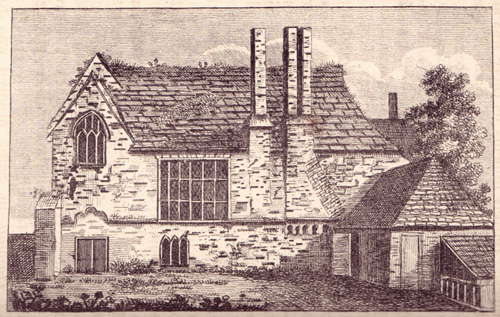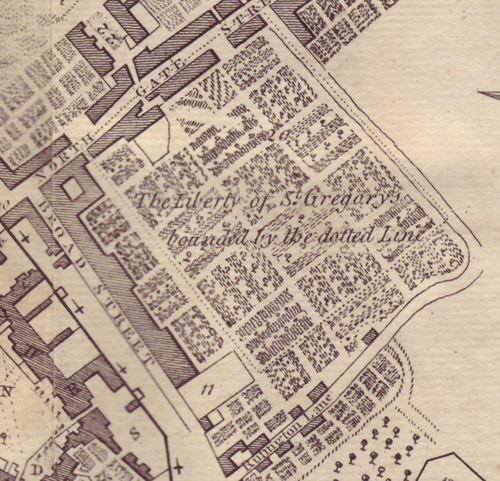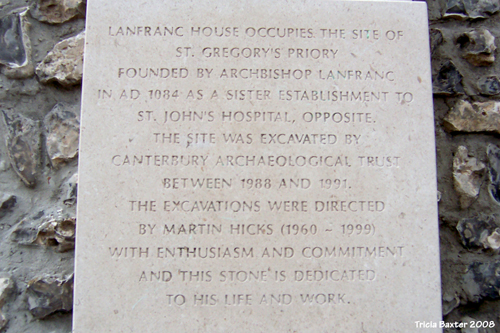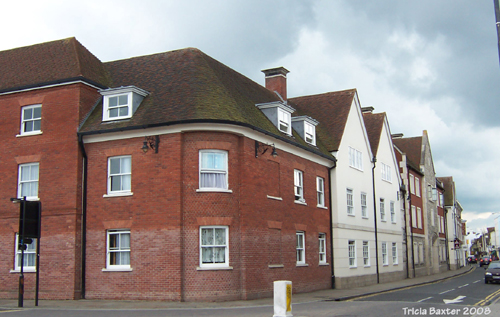
![]()
~ ST. GREGORY'S PRIORY ~
90-91 NORTHGATE STREET, CANTERBURY
Torn down c.1848

"ST. GREGORY'S" Drawing from Canterbury in the Olden Time by John Brent, 1879

The Liberty of "ST. GREGORY'S" bounded by the dotted line. 1777 map
In the yere of our Lorde 1537 the xxiij day of February, the monasterie of Seynet Gregories was suppressed and the chanons were expulsed; mr. Spilman and mr. Candish (should be Candel) being the kynges commissioners herunto appointed.
Narrative of the days of the reformation 1859

A detail from an old map in my possession, St. Gregory's highlighted in red. On the opposite side of street of Northgate we see St. John's Hospital

The buildings which now stand on the site of the old St, Gregory's Priory
He built also, on the opposite side of the way, a church, to the honour of St. Gregory, where he placed canons regular, who should administer spiritual comfort and assistance to the infirm people above mentioned, and take the care of their funerals, for which he provided them with such an income as was thought sufficient. Part of this priory is still standing, and many fine old arches and windows of the Saxon and Gothic order, may be seen. The belfry is also still remaining; but the whole seems from time and desolation, sinking "in ruinous decay." It is now made use of as a pottery and tobacco pipe manufactory. The ground belonging to its precincts, was formerly almost entirely laid out in gardens for the supply of our markets; but since the commencement of the late war, buildings have been erected on it, for the accomodation of the military, called St. Gregory's barracks. The chapel of St. Thomas (whose ruins were till within these few years remaining) had over the door, at the west end of it, a handsome old arch, which the archbishops lessee took down some years since, to make a portal to his own dwelling house, at St. Thomas's Hill; but that being sold and rebuilt, the Rev. Mr. Brockman, by adapting the front of one of his out-buildings to it, has preserved this piece of antiquity, and added to the beauties of his seat at Beachborough, near Hythe.
Opposite to this priory is St. John's hospital, and the church dedicated to St. Gregory is now the chapel of that hospital, but both have suffered much since Mr. Somner and Mr. Battely described them; the bells having been sold, the steeple and north aisle taken down, as were many of the old houses, and smaller and less convenient ones erected in their room. A stone wall was also taken away, which sheltered the whole from the cold north-west wind blowing over the river and the meadow land, and being pentised over head, was called by the poor people their cloisters, under which they used to walk, or sit and converse with each other on the benches. All this was done by way of improvement, about eighty years ago, (in 1747). William Gostling 1825
"St. Gregory's Priory - an extensive burying-ground was attached to it, not appropriate to the hospital alone, but to the parishioners of Northgate."
Canterbury in the Olden Time, second edition, John Brent, F.S.A. 1879
This cemetery or church yard at St. Gregory's continued to the use of the parish of Northgate, after the dissolution, until, as it is said, Sir John Boys, the lessee of the priory, obtained the appropriating and inclosing it, upon exchange of the modern churchyard ground for it, with the churchwardens of Northgate for the time being. Till this time then it continued to that parish, as to the fact a burial place, but was not acknowledged theirs of right; for at a visitation holden in the year 1560, a presentment from the parish of Northgate was made by sworn men; that Mr. May, then it seems lessee of the priory; did withold part of the church yard, &c. upon which he, in defence of himself, being convened upon this presentment, produced the king's letters patent, as the act of court ran, by which it appeared, that the church-yard was the hereditary right of the archbishop of Canterbury and his successors. Hasted
"St. Gregory's Hospital, founded by Archbishop Lanfranc; valued at the reformation at 166l. 4s. 5 1/2d. yearly, now worth 3,328l. 9s. 2d.; granted to the Archbishop of Canterbury."
A geographical dictionary of England and Wales, William Cobbett 1832 *granted 28 Henry VIII. to the Archbishop of Canterbury

"The priory of St. Gregory, according
to Tanner, was founded by Archbishop Lanfranc, in A.D. 1084, for infirm
men and women, for attendance upon whom he appointed regular canons
of the order of St. Augustine. It was made a priory of Black Canons,
temp. Henry I. by Archbishop William. The establishment is mentioned
in the Domesday Book, and is thought to have been the first house of
regular canons in the kingdom. It was burnt in 1145. An engraving in
my possession, made in 1717, does not define its architectural character
with precision, and it seems to have been adapted to modern uses. A
small part still existing. Its site was between Northgate Street and
the new military road, and is now nearly occupied by buildings. The
further history of this Priory is thus told by Gostling. "The ground
belonging to its precinct is almost entirely laid out in gardens for
our market. The chapel of St. Thomas (whose ruins are, or were, lately
all there) had over the door at the west end of it, a handsome old arch,
which the Archbishop's lessee took down some years ago, to make a portal
to his own dwelling-house, at St. Thomas' Hill; but that being sold
and rebuilt, the Rev. Mr. Brockman, by adapting the front of one of
his outbuildings to it, has preserved this piece of antiquity, and added
to the beauties of his seat at Beachborough, near Hythe."
Felix Summerly's "Hand-book for the city of Canterbury," 1843
"The priory of St. Gregory was founded by Archbishop Lanfranc in the year 1084, and was situated on the high road leading to the isle of Thanet. The founder established this house for secular canons, which Archbishop Corboil changed to regular canons, otherwise black canons, from the habit which they wore of hte order of St. Augustine. John Symkins was prior of this house at the dissoultion of it, 27th of Henry VIII., when there were thirteen religious in it, the yearly revenue being, according to Dugdale, 121l, 15s. 1d. In the same year the King exchanged the site with the Archbishop of Canterbury, and it was eventually sold to G. Gipps, Esq., he died possessed of it in the year 1800, and vested it in trust for the uses of his will. Its site was between Northgate street and the new Military road, and is now almost covered with modern buildings; a small part of the priory is, however still to be traced. The ancient house of the priory was formerly the residence of Sir John Boys, but has been many years in a ruined state."
Directory 1847
"In Northgate street was a religious house founded in 1084, by Lanfranc, for Secular priests, and dedicated to St. Gregory; the revenue, at the Dissolution, was £166. 4. 5.: the remains, consisting of parts of the walls, arches, and some windows in the Norman and early English styles of architecture, have been converted into a pottery, and a tobacco-pipe manufactory.
The barracks erected on the site of St. Gregory's Priory, and in other parts of the city, have been taken down, and new streets of small houses occupy their places."
A Topographical Dictionary of England 1848
"St. Gregory is another religious house supposed also to owe its foundation to Lanfranc, A.D. 1084. It was erected for secular priests, but in the time of Henry I., it was constituted a Priory of Black Canons. Somner, however, considers that its building was divided into two parts, one for infirm men, the other for infirm women, to whom the ecclesiastics were to administer religious offices. Battley informs us there was anciently the Capel of the Brotherhood of Saint Thomas the Martyr, situated in the garden of St. Gregory. At the time of the dissolution, it contained 13 Religious. Grove states its original foundation was for sick men and women. An extensive burying-ground was attached to it, not appropriate to the hospital alone, but to the parishioners of Northgate. The Canons of St. Gregory were allowed 4 acres of the best wheat and 4 acres of the best barley, cut from the manor of Northfleet."
Canterbury in the Olden Time, second edition, John Brent, F.S.A. 1879

A view of Northgate showing the Lanfranc House which is on the site of St. Gregory's Priory
"This priory was another foundation of Archbishop Lanfranc it was intended for infirm men and women, and regular canons of the order of St. Augustine had charge of it. It is supposed to be the first house of regular canons in this kingdom. The establishment is mentioned in the Doomsday book. Its site was between Northgate Street and the new Military Road, and is now almost covered with modern buildings a small part of the priory is, however still to be traced."
Goulden's Guide to Canterbury and the Cathedral c. 1890's
There is a drawing of St. Gregory's, Canterbury, Kent made May 17th, 1787, engraved by J. Newton, published by J. Hooper which shows a small building (shed) in front of the arch on the left side of the picture, and which also shows the arches in more detail